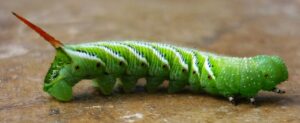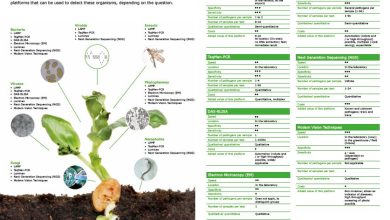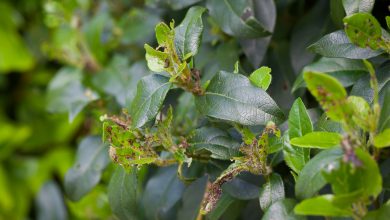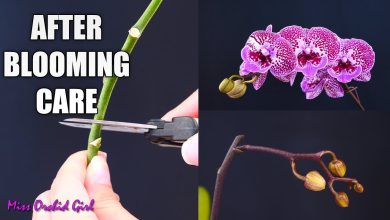Tomato Caterpillar: [How to Identify and Fight It]

 Manduca quinquemaculata or tomato caterpillar is a five-point worm, or a brown and gray hawk moth of the Sphingidae family .
Manduca quinquemaculata or tomato caterpillar is a five-point worm, or a brown and gray hawk moth of the Sphingidae family .
The tomato caterpillar, often known as the tomato hornworm, can be a major pest in gardens and orchards; It gets its name from a dark projection at its rear end and from being a common host on tomato plants.
Tomato hornworms are closely related to the tobacco hornworm Manduca (often misleading).
This confusion arises because the caterpillars of both species have similar morphologies and feed on the foliage of several plants of the Solanaceae family, so either of the two species can be found on tobacco or tomato leaves .
Tomato caterpillar characteristics
- The worms cuckolds of tomato are very large caterpillars with a tail like a horn.
- His favorite plant is the tomato.
- Horned worms chew on leaves and can completely defoliate plants.
- They can also chew holes in the fruit.
 Tomato worms are known to feed on various plants in the nightshade family , and commonly feed on tomato, eggplant , bell pepper , tobacco, moonflower , and potato .
Tomato worms are known to feed on various plants in the nightshade family , and commonly feed on tomato, eggplant , bell pepper , tobacco, moonflower , and potato .
Females prefer to oviposit on young leaves near the stem of host plants, and early-stage caterpillars can often be found here during the day.
In the afternoon or early morning when the sunlight is less direct, the caterpillars will feed on the more distal leaves.
Adult caterpillars or worm
Adults feed on nectar from flowering plants such as Datura meteloides, Oenothera caespitosa, and Mirabilis multiflora.
Most of the food plants they target have large, fragrant white flowers.
Interactions with host tomato plants
 Hawks, including M. quinquemaculata , are the main pollinators of D. meteloides.
Hawks, including M. quinquemaculata , are the main pollinators of D. meteloides.
The length of the moth proboscis (about 10 cm), which is an elongated tubular mouthpiece used for sucking and feeding, is efficient in retrieving nectar from flowers.
In addition to being a host plant for M. quinquemaculata, D. meteloides has also been used by humans for its opioid effects. D. meteloides contains tropane alkaloids, which are present throughout the plant, including the flowers.
These alkaloids have an intoxicating effect on the moth, showing erratic flight patterns as well as uncoordinated, and often unsuccessful, landing attempts after consuming the nectar.
Despite the damage caused by nectar, moths have been observed to return to the flowers and consume more nectar. It has been hypothesized that «spiky» nectar offers moths a reward that goes beyond just nutrients.
Both Mirabilis multiflora and Oenothera caespitosa also depend on hawkmoth pollinators for their pollination .
The tomato caterpillar has been found to feed first on Oenothera caespitosa and only then visit Mirabilis multiflora, indicating a preference for the former.
Life cycle of the tomato caterpillar
- Tomato worms survive the winter as pupae and emerge as adult moths in spring .
- After mating, females lay oval, smooth, light green eggs on the surfaces of the lower and upper leaves.
- The caterpillars hatch, begin feeding, and are fully grown in three to four weeks.
- Mature caterpillars drop the plants and burrow into the ground to pupate.
- The moths emerge in two weeks to start a second generation, in mid- summer .
- Second-generation moths lay eggs on host plants, such as tomatoes.
- The caterpillars feed until late summer or early fall and then pupate.
- The pupae remain in the ground during the winter .
Identify the tomato worm: What damage does it cause?
 Hornworms can be up to 12 centimeters long, so they can impress you the first time you meet them.
Hornworms can be up to 12 centimeters long, so they can impress you the first time you meet them.
They do the most damage at the caterpillar or larva stage. They are pale green with black and white markings, plus a horn-shaped bump protruding from their butt. (Don’t worry, they are unable to sting or bite!)
The caterpillar also has eight V-shaped stripes on its green body. Tomato hornworms come from a grayish-brown speckled moth (see photo, above).
The larvae mix very well with the greenery of the plant. Get used to a daily patrol, looking for worm eggs and tiny caterpillars. Here are some signs of infestations:
- Hornworms tend to start feeding off the top of the plant; Look for chewed or missing leaves.
- Look closely at the tops of the tomato leaves for dark green or black droppings left behind by the larvae that feed on the leaves.
- Then look at the underside of the leaves. You will likely find a horn worm.
- Look for stems that are missing some leaves and wilted leaves that hang down. You may find white cocoons and their worm hosts around.
There are many herbs that serve as alternative hosts, including horseweed, jimsonweed, and belladonna . Large numbers of caterpillars can appear in home gardens and can quickly defoliate plants.
As they feed, they create dark green or black droppings that are clearly visible. Older tomato worms can destroy various leaves as well as the fruit.
As they grow, the amount of defoliation increases. The last stage of the caterpillar consumes almost as much as all the younger stages combined.
How to fight the tomato caterpillar
- Check your plants for tomato worms at least twice a week during the summer.
- Eliminate weeds to reduce the number of sites where worms can lay eggs.
- Cultivate the soil after harvest to destroy caterpillars and pupae.
Eliminate worms from tomato plants
This is the most effective means of controlling this pest. Tomato worms are easy to find due to their large size.
You can spray them with potassium soap or neem oil to finish them off once identified.
Natural enemies of the tomato worm
A green caterpillar on a green leaf with several white cocoons on its back is a parasitized hornworm. There are many natural enemies of the tomato worm.
General predatory insects, such as lady beetles and green pupae, often feed on the egg stage and young caterpillars.
Another important predator is the paper wasp, Polistes spp . This common wasp feeds on many types of caterpillars including those found in gardens.
Tomato worms are also parasitized by various insects. One of the most common is a small braconid wasp, Cotesia congregatus . The larvae that hatch from the wasp’s eggs are laid on the hornworm.
The larvae of the wasp feed on the inside of the worm until the wasp is ready to pupate. The cocoons look like white rice sticking out of the worm’s body.
If you see this happening, leave the worms in the garden to allow the adult wasps to emerge. These wasps kill the worms when they emerge from the cocoons. Then the wasps look for other worms to parasitize.




